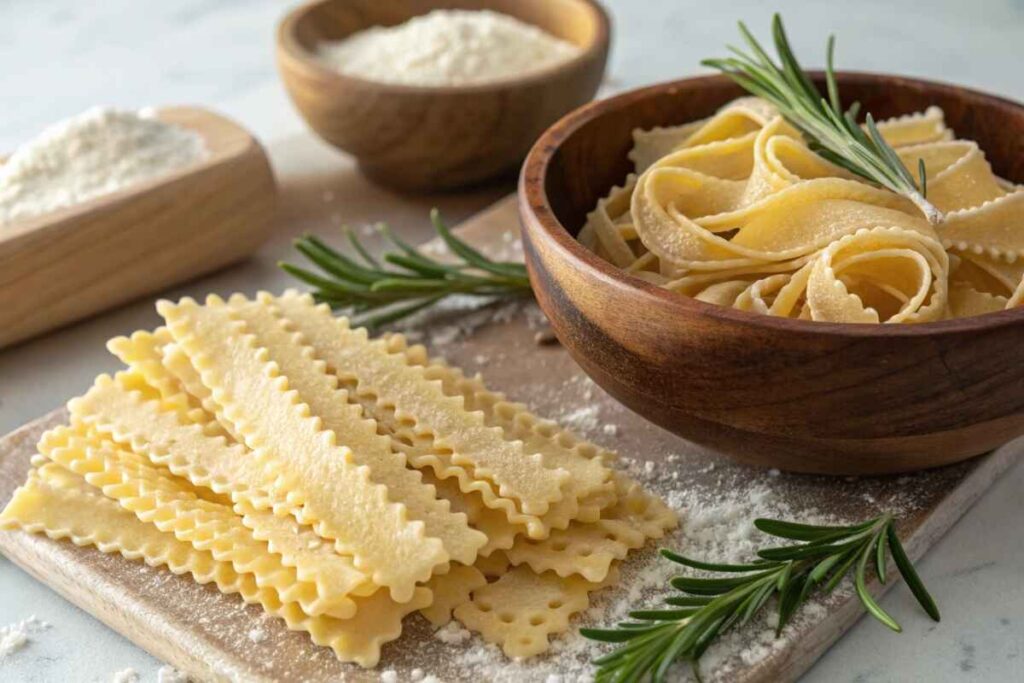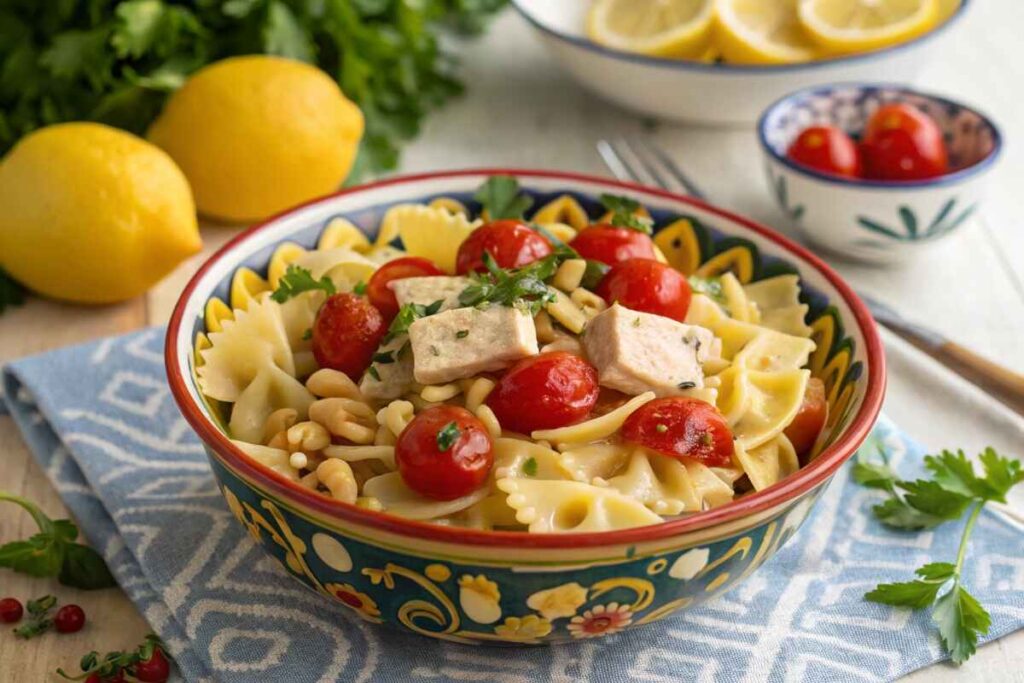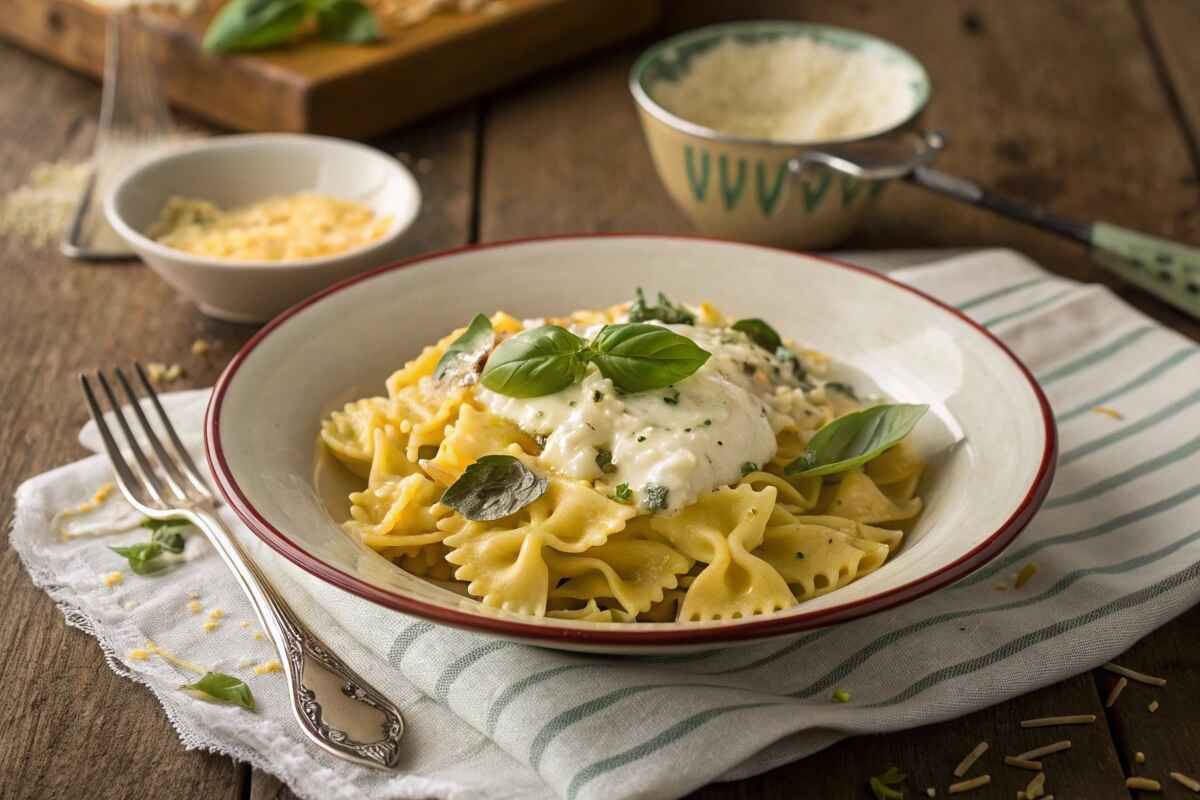What is Mafaldine Pasta?
Table of Contents
Mafaldine—also called reginette (meaning “little queens”)—is a long, ribbon-like pasta with wavy edges that give it a regal appearance. It’s crafted from durum wheat semolina and water, traditionally extruded through bronze dies for a rough texture that holds sauces beautifully. This pasta’s distinct scalloped edges not only add elegance but also enhance its ability to carry flavorful sauces.
Origins and Naming of Mafaldine
Mafaldine takes its name from Princess Mafalda of Savoy, an Italian royal born in 1902. Some believe the pasta was created in her honor, though others claim it existed earlier under a different name, manfredine. Regardless of its exact origins, the pasta was renamed to celebrate the princess, cementing its royal connection.
Synonyms and Regional Variations
Depending on where you are in Italy, you might encounter mafaldine under different names. In Sicily, it’s sometimes called margherita, while shorter variations are known as mafaldine corte. Whether gluten-free, whole grain, or traditional, this versatile pasta remains a favorite across Italy for both its unique appearance and culinary adaptability.
Historical Background of Mafaldine Pasta
The Story of Princess Mafalda of Savoy
The name mafaldine pasta honors Princess Mafalda of Savoy, the daughter of King Victor Emmanuel III of Italy. This illustrious royal was not just known for her lineage but also for her tragic life story. Though the pasta’s exact origins remain debated, many believe it was renamed to celebrate Mafalda’s grace and charm. The scalloped edges of mafaldine are said to mimic the delicate waves of her hair or the elegance she embodied.
The Tragic History Behind the Name
Sadly, Princess Mafalda’s life was marred by hardship. During World War II, her marriage to a German prince placed her in a precarious position as tensions between Italy and Germany escalated. When Italy signed an armistice with the Allies in 1943, the Nazis arrested Mafalda, suspecting her of anti-German activities. She was sent to Buchenwald concentration camp, where she later died tragically. This poignant connection adds a layer of depth to the pasta’s legacy, making it a culinary homage to resilience and history.
Cultural Significance in Italy
Beyond its royal connection, mafaldine pasta holds a special place in Italian culinary tradition. It symbolizes both the creativity of pasta makers and the enduring influence of Italian history in food culture. Even today, Italians cherish mafaldine as a versatile pasta that bridges historical significance with modern culinary trends.
Characteristics and Types of Mafaldine Pasta
Shape, Texture, and Ingredients

Mafaldine pasta stands out for its long, ribbon-like shape with wavy edges. This unique design serves both form and function—it’s aesthetically pleasing and adept at holding sauces, making every bite flavorful. Typically crafted from durum wheat semolina and water, mafaldine is extruded through bronze dies to create a rough texture that enhances sauce adhesion.
Comparison to Similar Pasta Types
Mafaldine often draws comparisons to lasagna noodles, given their similar length and flat structure. However, the ruffled edges of mafaldine give it a distinctive elegance that sets it apart. Unlike wide pasta types like pappardelle, mafaldine’s wavy borders add visual appeal and a playful texture that makes it a favorite among chefs and home cooks alike.
Traditional vs. Modern Variants
Over time, mafaldine has evolved to suit diverse dietary preferences. Today, you can find gluten-free and whole-grain versions alongside the traditional semolina-based pasta. There’s even a shorter variant called mafaldine corte, perfect for hearty soups or creamy sauces. Regardless of the version, mafaldine pasta continues to embody Italy’s passion for food innovation and tradition.
Regional Culinary Applications of Mafaldine Pasta
Neapolitan Recipes: Simple and Elegant
In Naples, mafaldine pasta takes center stage in recipes that highlight the region’s love for simplicity. One popular preparation is mafaldine con ricotta in bianco, a creamy dish made with sheep’s milk ricotta, lardo, and pecorino cheese. Another classic is mafaldine con ceci, a humble yet flavorful recipe featuring chickpeas and a hint of garlic. The pasta’s scalloped edges capture every drop of these light sauces, creating a perfect harmony of flavors.
Sicilian Dishes: Swordfish and Anchovies

Sicilian cuisine offers a bolder approach to mafaldine pasta. A traditional favorite is mafaldine with swordfish, often enriched with tomatoes, pine nuts, and raisins to add a sweet-savory twist. Another beloved recipe includes anchovies, tomato paste, and breadcrumbs, showcasing Sicily’s love for seafood. These dishes not only honor the island’s culinary heritage but also demonstrate the versatility of mafaldine in pairing with robust flavors.
Puglian Festive Dishes: La Barba di San Giuseppe
In Puglia, mafaldine plays a special role during the celebration of St. Joseph’s Day. The dish, called La Barba di San Giuseppe or “St. Joseph’s beard,” uses the wavy pasta to symbolize the saint’s facial hair. It’s traditionally served with a simple sauce of breadcrumbs, anchovies, and olive oil, reflecting the region’s rustic charm and deep-rooted culinary traditions.
How to Cook and Serve Mafaldine Pasta
Cooking Tips for Perfect Mafaldine
Cooking mafaldine pasta to perfection requires attention to detail. Use plenty of salted water to prevent sticking, and stir occasionally to ensure even cooking. Due to its thick texture, mafaldine typically requires a slightly longer cooking time than other pasta types. Al dente is the way to go—it should retain a slight firmness for the best texture.
Best Sauces and Pairings
Mafaldine pasta excels at holding sauces, making it ideal for a variety of preparations. Creamy sauces like ricotta-based blends or béchamel work wonders, while tomato-based sauces with a hint of spice are equally delightful. For a lighter option, try olive oil-based sauces with garlic, herbs, and fresh vegetables. Seafood, especially shrimp or calamari, pairs beautifully with mafaldine, elevating it to a gourmet dish.
Common Mistakes to Avoid
Even seasoned cooks can make mistakes with mafaldine pasta. Avoid overcooking, as it can lose its texture and become gummy. Be mindful of sauce-to-pasta ratios; mafaldine thrives in dishes with enough sauce to coat its ruffled edges. Finally, steer clear of overly heavy sauces that might overwhelm the pasta’s delicate structure and taste.
Frequently Asked Questions about Mafaldine Pasta
What Does Mafaldine Mean in Italian?
The word mafaldine is derived from the name of Princess Mafalda of Savoy, symbolizing elegance and regality. In Italian, the name mafaldine translates to “little Mafaldas,” referring to the scalloped edges of the pasta that mimic the delicate waves of her hair. The term also highlights the pasta’s royal origin, making it a beloved staple in Italian cuisine.
Is Mafaldine Pasta the Same as Lasagna Noodles?
While mafaldine pasta and lasagna noodles share some similarities, such as their flat shape, they are distinct in design and purpose. Mafaldine’s ruffled edges set it apart, providing a decorative and functional flair that holds sauces beautifully. Lasagna noodles, on the other hand, are typically wider and lack the signature wavy edges that define mafaldine.
What Makes Mafaldine Pasta Unique Among Pasta Types?
The unique combination of its scalloped edges, long ribbon-like structure, and rough texture make mafaldine pasta stand out. Its ability to hold both light and hearty sauces makes it incredibly versatile. Additionally, the pasta’s royal connection and history add a special touch that elevates it beyond mere sustenance into a culinary experience.
How Do Italians Traditionally Serve Mafaldine?
In Italy, mafaldine pasta is often paired with regional sauces that highlight its versatility. Neapolitans favor creamy ricotta-based sauces, while Sicilians often prepare it with seafood and tomatoes. Regardless of the region, mafaldine is celebrated for its ability to adapt to a variety of cooking styles, from simple weekday meals to elaborate festive dishes.
Conclusion and Final Thoughts
Why Mafaldine Deserves a Place in Your Kitchen
Whether you’re a seasoned cook or a pasta enthusiast, mafaldine pasta deserves a spot in your repertoire. Its unique texture, versatility, and historical significance make it a standout choice for elevating your meals. With so many traditional and modern recipes to explore, mafaldine offers endless possibilities to create memorable dishes.
Exploring Italy One Dish at a Time
From its royal roots to its culinary versatility, mafaldine pasta is a testament to Italy’s rich food culture. By preparing this pasta, you’re not just enjoying a meal—you’re savoring a piece of history. So, grab some mafaldine, whip up your favorite sauce, and experience the magic of Italian cuisine in your own kitchen.
Creative Recipes Using Mafaldine Pasta
Exploring Fusion Cuisine
Mafaldine pasta is not limited to traditional Italian recipes—it shines in fusion dishes too! For a creative twist, try using mafaldine in an Asian-inspired stir-fry. Toss it with soy sauce, sesame oil, fresh ginger, and sautéed vegetables like bell peppers and snap peas. The wavy edges of mafaldine soak up the flavorful sauce, creating a delightful blend of textures and tastes.
Another fusion favorite is a creamy Cajun-style mafaldine. Combine the pasta with a spicy Cajun cream sauce, shrimp, and smoked sausage for a bold, mouthwatering dish. The scalloped edges of mafaldine capture every bit of the rich, spiced sauce.
Modern Takes on Classic Dishes
If you love experimenting, use mafaldine pasta as a substitute in classic dishes. For example, swap it for lasagna sheets in a deconstructed lasagna bake. Layer mafaldine with béchamel, ricotta, marinara, and ground meat, then bake it until golden and bubbly.
Alternatively, prepare a mafaldine carbonara by tossing the pasta in a creamy egg-based sauce with crispy pancetta and grated Parmesan. This modern twist adds a playful element to a beloved classic, thanks to mafaldine’s unique shape.
The Global Influence of Mafaldine Pasta
Adapting Mafaldine to Diverse Cuisines
Mafaldine pasta has found its way into kitchens worldwide, adapting to local flavors and traditions. In American cuisine, it’s often paired with hearty, cheesy sauces, turning it into a comfort food staple. Meanwhile, in Mediterranean-inspired dishes, mafaldine is used with olive oil, fresh herbs, and grilled vegetables, creating light yet satisfying meals.
In Southeast Asia, chefs have embraced mafaldine’s versatility by incorporating it into soups and curries. Its wavy edges hold up well in broths, making it an excellent addition to flavorful noodle dishes.
Why Mafaldine is a Global Favorite
The adaptability of mafaldine pasta is one of the reasons for its global appeal. Whether used in traditional Italian recipes or modern culinary experiments, its unique texture and shape make it an ideal choice. Moreover, its aesthetic charm elevates even the simplest dishes, ensuring that it’s as visually appealing as it is delicious.
To conclude your journey into the world of Mafaldine pasta, its history, unique recipes, and expert tips highlight its versatility and rich cultural heritage. Whether you’re crafting a decadent sauce or exploring creative pairings, Mafaldine offers an experience that combines tradition and innovation. For more culinary inspiration and delightful recipes, explore CooFoodKing to continue expanding your kitchen repertoire. Cooking, like life, is always better with a twist of creativity and passion!
